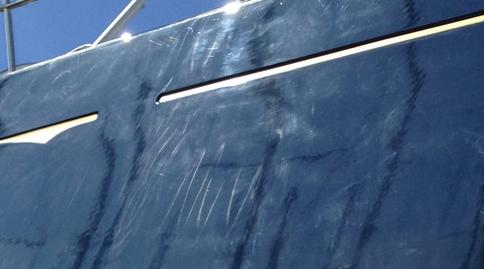For those that will read this into the future that might not know what the problem is shown in the full size picture, I've cropped out the section where the holograms are visible.

The thing to keep in mind is that these holograms are not just in this section, they are all over the hull.
You need the sun to light up the hull to see them or in this case photograph them and sometimes this can be kind of tricky.
Holograms are technically scratches inflicted into the gel-coat from the use of these three things,
- Rotary buffer
- Wool pads
- Abrasives (compounds, polishes and even some cleaner/waxes)
Holograms leave the gel-coat MORE OPENED up than finishing out with a dual action polisher and leaving zero scratches behind.
The millions and millions of scratches increase the surface area by 2 to 3 times the original surface are (if not more), and thus accelerates the oxidation process.
There's nothing beneficial or positive about buffing out a boat and leaving holograms in the hull. Nothing.
At my boat detailing classes I teach guys how to finish out hologram-free using dual action polishers like,
- Flex 3401
- RUPES Bigfoot 21
- Cyclo polisher
- Porter Cable dual action polisher
- Griot's Garage dual action polishers
Heck any dual action polisher with a little education will remove holograms and leave a flatter, more smoother surface to be sealed and this will resist oxidation longer as well as simply LOOK better.
Using top shelf abrasive technology is still vitally important even with dual action polishers or instead of leaving holograms you'll leave micro-marring which is also a type of scratch pattern.
